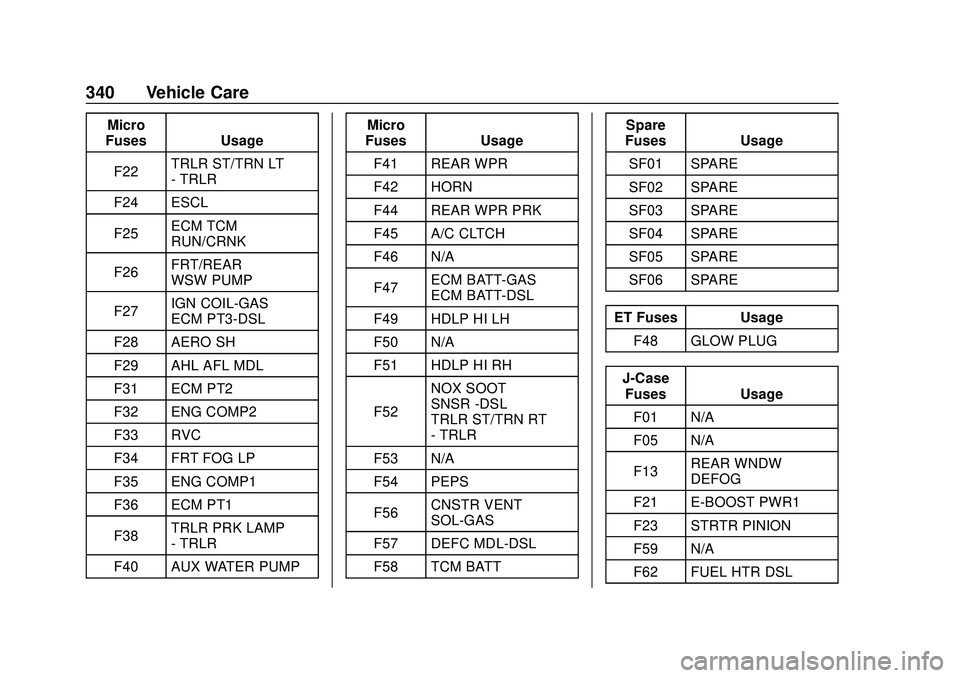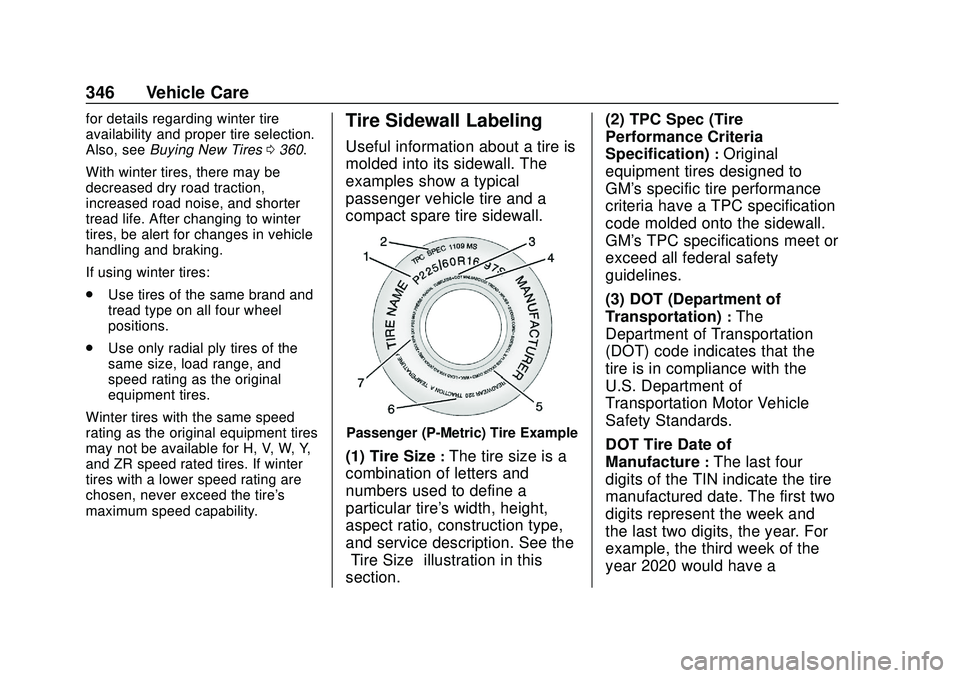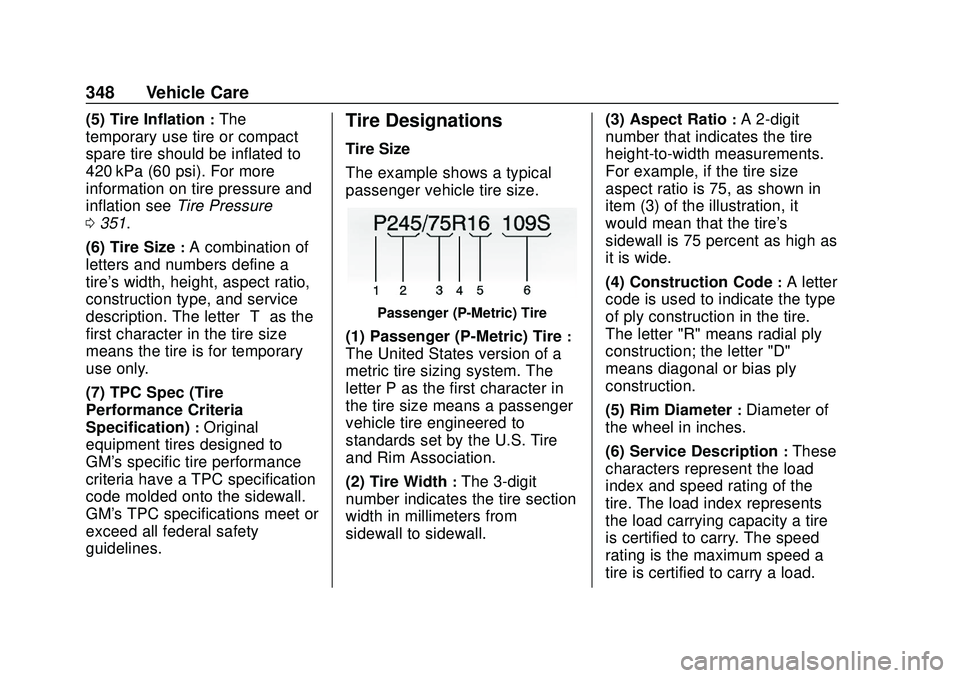BUICK ENCORE GX 2020 Owner's Manual
Manufacturer: BUICK, Model Year: 2020, Model line: ENCORE GX, Model: BUICK ENCORE GX 2020Pages: 442, PDF Size: 11.64 MB
Page 341 of 442

Buick Encore GX Owner Manual (GMNA-Localizing-U.S./Canada/Mexico-
14018934) - 2020 - CRC - 2/27/20
340 Vehicle Care
Micro
Fuses Usage
F22 TRLR ST/TRN LT
- TRLR
F24 ESCL
F25 ECM TCM
RUN/CRNK
F26 FRT/REAR
WSW PUMP
F27 IGN COIL-GAS
ECM PT3-DSL
F28 AERO SH
F29 AHL AFL MDL
F31 ECM PT2
F32 ENG COMP2
F33 RVC
F34 FRT FOG LP
F35 ENG COMP1
F36 ECM PT1
F38 TRLR PRK LAMP
- TRLR
F40 AUX WATER PUMP Micro
Fuses Usage
F41 REAR WPR
F42 HORN
F44 REAR WPR PRK
F45 A/C CLTCH
F46 N/A
F47 ECM BATT-GAS
ECM BATT-DSL
F49 HDLP HI LH
F50 N/A
F51 HDLP HI RH
F52 NOX SOOT
SNSR -DSL
TRLR ST/TRN RT
- TRLR
F53 N/A
F54 PEPS
F56 CNSTR VENT
SOL-GAS
F57 DEFC MDL-DSL
F58 TCM BATT Spare
Fuses Usage
SF01 SPARE
SF02 SPARE
SF03 SPARE
SF04 SPARE
SF05 SPARE
SF06 SPARE
ET Fuses Usage F48 GLOW PLUG
J-Case Fuses Usage
F01 N/A
F05 N/A
F13 REAR WNDW
DEFOG
F21 E-BOOST PWR1
F23 STRTR PINION
F59 N/A
F62 FUEL HTR DSL
Page 342 of 442

Buick Encore GX Owner Manual (GMNA-Localizing-U.S./Canada/Mexico-
14018934) - 2020 - CRC - 2/27/20
Vehicle Care 341
J-CaseFuses Usage
F63 N/A
M-case Fuses Usage
F04 FRT WPR
F30 STRTR SOL
F37 AUX OIL PUMP
F39 N/A
F43 PWR WNDW RT
F55 PWR WNDW LT
F60 DEF HTR
F61 N/A
Mini
Relays Usage
K03 RUN/CRNK
K04 REAR DEFOG
K06 STRTR PINION
K08 PT RLY
K09 FUEL HTR DSL HC Micro
Relays Usage
K01 N/A
K02 N/A
K05 STRTR SOL
K07 A/C CNTRL
K10 N/A
Ultra
Micro
Relays Usage
K11 N/AInstrument Panel Fuse
Block
The instrument panel fuse block is
on the underside of the driver side
instrument panel. To access the
fuses, open the fuse cover by
pulling out. To reinstall the cover,
insert the top tab first, then push the
cover back into its original location.
Page 343 of 442

Buick Encore GX Owner Manual (GMNA-Localizing-U.S./Canada/Mexico-
14018934) - 2020 - CRC - 2/27/20
342 Vehicle Care
FuseUsage
F01 LUMBAR
F02 SUNROOF Fuse
Usage
F03 VBAT_3
F04 VBAT_7
F05 VBAT_6
F06 AUTO HVAC
F07 CGM
F08 ST_WHL_HTR
F09 DISPLAY
F10 RADIO F11 ONSTAR
F12 PARK_ASSIST
F13 MAN. HVAC
F14 WL CHARGER
F15 VBAT_2
F16 VBAT_1
F17 SWC BKLT
F18 N/A
F19 N/A
F20 CLOCK SPRING
F21 OCC SEN Fuse
Usage
F22 DLC
F23 SDM
F24 IGN_SW/ESCL
F25 PWR L-GATE MDL
F26 SEC FUSE-2
F27 PWR SEAT CO-DR
F28 VBAT_8
F29 DC-DC AT
DC-DC MT
F30 PWR L-GATE MDL
F31 OSRVM
F32 FRT HS PWR-1
F33 VBAT_4
F34 FRT HS PWR-2
F35 AMPLIFIER
F36 SEC FUSE-1
F37 PWR SEAT DR
F38 DC-DC_400W
DC-DC_200W
F39 N/A
Page 344 of 442

Buick Encore GX Owner Manual (GMNA-Localizing-U.S./Canada/Mexico-
14018934) - 2020 - CRC - 2/27/20
Vehicle Care 343
FuseUsage
F40 HVAC_BLOWER
Circuit
Breaker Usage
CB1 N/A
CB2 APO
Relay Usage
K01 i-RAP_ACC
K02 RUN
K03 LOGISTICS
K04 N/A
K05 N/A
K06 N/ARear Compartment Fuse
Block
The rear compartment fuse block is
behind a cover on the driver side of
the rear compartment. To access
the fuses, remove the cover.
Fuse Usage
F01 N/A
F02 RDCM ELEC
Page 345 of 442

Buick Encore GX Owner Manual (GMNA-Localizing-U.S./Canada/Mexico-
14018934) - 2020 - CRC - 2/27/20
344 Vehicle Care
FuseUsage
F03 N/A
F04 N/A
F05 DC/AC INVERTER
F06 N/A
F07 RDCM
F08 RR SEAT
HEAT PWR1
F09 N/A
F10 RR SEAT
HEAT PWR2
F11 N/A
F12 N/A
F13 N/A
F14 N/A
F15 N/A
F16 N/A
F17 N/A
F18 N/A
F19 N/A
F20 N/A Fuse
Usage
F21 N/A
Circuit
Breakers Usage
CB1 N/A
Relays Usage
K01 N/A
K02 N/A
K03 N/A
K04 N/A
K05 N/AWheels and Tires
Tires
Every new GM vehicle has
high-quality tires made by a
leading tire manufacturer. See
the warranty manual for
information regarding the tire
warranty and where to get
service. For additional
information refer to the tire
manufacturer.
{Warning
.Poorly maintained and
improperly used tires are
dangerous.
.Overloading the tires can
cause overheating as a
result of too much
flexing. There could be a
blowout and a serious
crash. See Vehicle Load
Limits 0232.
(Continued)
Page 346 of 442

Buick Encore GX Owner Manual (GMNA-Localizing-U.S./Canada/Mexico-
14018934) - 2020 - CRC - 2/27/20
Vehicle Care 345
Warning (Continued)
.Underinflated tires pose
the same danger as
overloaded tires. The
resulting crash could
cause serious injury.
Check all tires frequently
to maintain the
recommended pressure.
Tire pressure should be
checked when the tires
are cold.
.Overinflated tires are
more likely to be cut,
punctured, or broken by
a sudden impact—such
as when hitting a pothole.
Keep tires at the
recommended pressure.
.Worn or old tires can
cause a crash. If the
tread is badly worn,
replace them.
(Continued)
Warning (Continued)
.Replace any tires that
have been damaged by
impacts with potholes,
curbs, etc.
.Improperly repaired tires
can cause a crash. Only
the dealer or an
authorized tire service
center should repair,
replace, dismount, and
mount the tires.
.Do not spin the tires in
excess of 56 km/h
(35 mph) on slippery
surfaces such as snow,
mud, ice, etc. Excessive
spinning may cause the
tires to explode.
All-Season Tires
This vehicle may come with
all-season tires. These tires are
designed to provide good overall
performance on most road surfaces and weather conditions. Original
equipment tires designed to GM's
specific tire performance criteria
have a TPC specification code
molded onto the sidewall. Original
equipment all-season tires can be
identified by the last two characters
of this TPC code, which will
be
“MS.”
Consider installing winter tires on
the vehicle if frequent driving on
snow or ice-covered roads is
expected. All-season tires provide
adequate performance for most
winter driving conditions, but they
may not offer the same level of
traction or performance as winter
tires on snow or ice-covered roads.
See Winter Tires 0345.
Winter Tires
This vehicle was not originally
equipped with winter tires. Winter
tires are designed for increased
traction on snow and ice-covered
roads. Consider installing winter
tires on the vehicle if frequent
driving on ice or snow covered
roads is expected. See your dealer
Page 347 of 442

Buick Encore GX Owner Manual (GMNA-Localizing-U.S./Canada/Mexico-
14018934) - 2020 - CRC - 2/27/20
346 Vehicle Care
for details regarding winter tire
availability and proper tire selection.
Also, seeBuying New Tires 0360.
With winter tires, there may be
decreased dry road traction,
increased road noise, and shorter
tread life. After changing to winter
tires, be alert for changes in vehicle
handling and braking.
If using winter tires:
. Use tires of the same brand and
tread type on all four wheel
positions.
. Use only radial ply tires of the
same size, load range, and
speed rating as the original
equipment tires.
Winter tires with the same speed
rating as the original equipment tires
may not be available for H, V, W, Y,
and ZR speed rated tires. If winter
tires with a lower speed rating are
chosen, never exceed the tire's
maximum speed capability.Tire Sidewall Labeling
Useful information about a tire is
molded into its sidewall. The
examples show a typical
passenger vehicle tire and a
compact spare tire sidewall.
Passenger (P-Metric) Tire Example
(1) Tire Size:The tire size is a
combination of letters and
numbers used to define a
particular tire's width, height,
aspect ratio, construction type,
and service description. See the
“Tire Size” illustration in this
section. (2) TPC Spec (Tire
Performance Criteria
Specification)
:Original
equipment tires designed to
GM's specific tire performance
criteria have a TPC specification
code molded onto the sidewall.
GM's TPC specifications meet or
exceed all federal safety
guidelines.
(3) DOT (Department of
Transportation)
:The
Department of Transportation
(DOT) code indicates that the
tire is in compliance with the
U.S. Department of
Transportation Motor Vehicle
Safety Standards.
DOT Tire Date of
Manufacture
:The last four
digits of the TIN indicate the tire
manufactured date. The first two
digits represent the week and
the last two digits, the year. For
example, the third week of the
year 2020 would have a
Page 348 of 442

Buick Encore GX Owner Manual (GMNA-Localizing-U.S./Canada/Mexico-
14018934) - 2020 - CRC - 2/27/20
Vehicle Care 347
four-digit DOT date of 0320.
Week 01 is the first full week
(Sunday through Saturday) of
each year.
(4) Tire Identification Number
(TIN)
:The letters and numbers
following the DOT (Department
of Transportation) code are the
Tire Identification Number (TIN).
The TIN shows the
manufacturer and plant code,
tire size, and date the tire was
manufactured. The TIN is
molded onto both sides of the
tire, although only one side may
have the date of manufacture.
(5) Tire Ply Material
:The type
of cord and number of plies in
the sidewall and under the tread.
(6) Uniform Tire Quality
Grading (UTQG)
:Tire
manufacturers are required to
grade tires based on three
performance factors: tread wear,
traction, and temperature resistance. For more information
see
Uniform Tire Quality
Grading 0362.
(7) Maximum Cold Inflation
Load Limit
:Maximum load that
can be carried and the
maximum pressure needed to
support that load.
Compact Spare Tire Example
(1) Tire Ply Material:The type
of cord and number of plies in
the sidewall and under the tread.
(2) Temporary Use Only
:The
compact spare tire or temporary
use tire should not be driven at speeds over 80 km/h (50 mph).
The compact spare tire is for
emergency use when a regular
road tire has lost air and gone
flat. If the vehicle has a compact
spare tire, see
Compact Spare
Tire 0371 and
If a Tire Goes Flat 0365.
(3) Tire Identification Number
(TIN)
:The letters and numbers
following the DOT (Department
of Transportation) code are the
Tire Identification Number (TIN).
The TIN shows the
manufacturer and plant code,
tire size, and date the tire was
manufactured. The TIN is
molded onto both sides of the
tire, although only one side may
have the date of manufacture.
(4) Maximum Cold Inflation
Load Limit
:Maximum load that
can be carried and the
maximum pressure needed to
support that load.
Page 349 of 442

Buick Encore GX Owner Manual (GMNA-Localizing-U.S./Canada/Mexico-
14018934) - 2020 - CRC - 2/27/20
348 Vehicle Care
(5) Tire Inflation:The
temporary use tire or compact
spare tire should be inflated to
420 kPa (60 psi). For more
information on tire pressure and
inflation see Tire Pressure
0 351.
(6) Tire Size
:A combination of
letters and numbers define a
tire's width, height, aspect ratio,
construction type, and service
description. The letter “T”as the
first character in the tire size
means the tire is for temporary
use only.
(7) TPC Spec (Tire
Performance Criteria
Specification)
:Original
equipment tires designed to
GM's specific tire performance
criteria have a TPC specification
code molded onto the sidewall.
GM's TPC specifications meet or
exceed all federal safety
guidelines.
Tire Designations
Tire Size
The example shows a typical
passenger vehicle tire size.
Passenger (P-Metric) Tire
(1) Passenger (P-Metric) Tire:
The United States version of a
metric tire sizing system. The
letter P as the first character in
the tire size means a passenger
vehicle tire engineered to
standards set by the U.S. Tire
and Rim Association.
(2) Tire Width
:The 3-digit
number indicates the tire section
width in millimeters from
sidewall to sidewall. (3) Aspect Ratio
:A 2-digit
number that indicates the tire
height-to-width measurements.
For example, if the tire size
aspect ratio is 75, as shown in
item (3) of the illustration, it
would mean that the tire's
sidewall is 75 percent as high as
it is wide.
(4) Construction Code
:A letter
code is used to indicate the type
of ply construction in the tire.
The letter "R" means radial ply
construction; the letter "D"
means diagonal or bias ply
construction.
(5) Rim Diameter
:Diameter of
the wheel in inches.
(6) Service Description
:These
characters represent the load
index and speed rating of the
tire. The load index represents
the load carrying capacity a tire
is certified to carry. The speed
rating is the maximum speed a
tire is certified to carry a load.
Page 350 of 442

Buick Encore GX Owner Manual (GMNA-Localizing-U.S./Canada/Mexico-
14018934) - 2020 - CRC - 2/27/20
Vehicle Care 349
Tire Terminology and
Definitions
Air Pressure:The amount of
air inside the tire pressing
outward on each square inch of
the tire. Air pressure is
expressed in kPa (kilopascal)
or psi (pounds per square inch).
Accessory Weight
:The
combined weight of optional
accessories. Some examples of
optional accessories are
automatic transmission, power
windows, power seats, and air
conditioning.
Aspect Ratio
:The relationship
of a tire's height to its width.
Belt
:A rubber coated layer of
cords between the plies and the
tread. Cords may be made from
steel or other reinforcing
materials. Bead
:The tire bead contains
steel wires wrapped by steel
cords that hold the tire onto
the rim.
Bias Ply Tire
:A pneumatic tire
in which the plies are laid at
alternate angles less than
90 degrees to the centerline of
the tread.
Cold Tire Pressure
:The
amount of air pressure in a tire,
measured in kPa (kilopascal)
or psi (pounds per square inch)
before a tire has built up heat
from driving. See Tire Pressure
0 351.
Curb Weight
:The weight of a
motor vehicle with standard and
optional equipment including the
maximum capacity of fuel, oil,
and coolant, but without
passengers and cargo.
DOT Markings
:A code molded
into the sidewall of a tire
signifying that the tire is in
compliance with the U.S. Department of Transportation
(DOT) Motor Vehicle Safety
Standards. The DOT code
includes the Tire Identification
Number (TIN), an alphanumeric
designator which can also
identify the tire manufacturer,
production plant, brand, and
date of production.
GVWR
:Gross Vehicle Weight
Rating. See Vehicle Load Limits
0 232.
GAWR FRT
:Gross Axle Weight
Rating for the front axle. See
Vehicle Load Limits 0232.
GAWR RR
:Gross Axle Weight
Rating for the rear axle. See
Vehicle Load Limits 0232.
Intended Outboard Sidewall
:
The side of an asymmetrical tire
that must always face outward
when mounted on a vehicle.
Kilopascal (kPa)
:The metric
unit for air pressure.